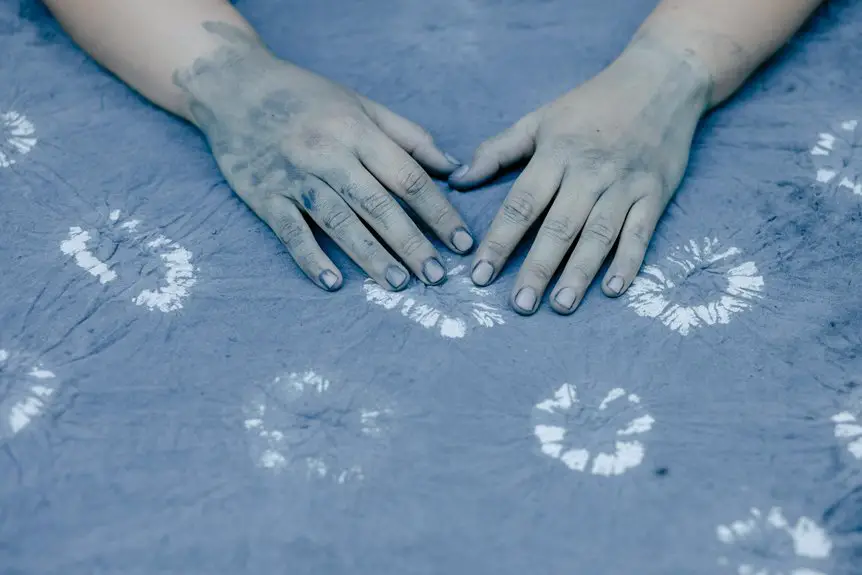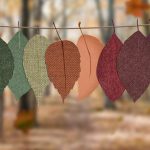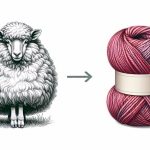If you want the brightest tie-dye colors, choose natural fabrics like cotton and silk. They soak up dye deeply, giving you vibrant, even patterns. Avoid synthetics like polyester since they resist dye and need special handling. Blended fabrics can be tricky—they might show uneven color but offer durability. Lighter, smooth-textured fabrics help colors pop more. Properly prepping your fabric by washing and soaking it first will boost dye absorption. Keep exploring to find the best fabric choices and prep tips for stunning results.
Table of Contents
Key Takeaways
- Natural fibers like cotton, silk, and wool absorb dye deeply for vibrant, long-lasting tie-dye results.
- Cotton is preferred for its softness, breathability, and ability to produce bright, consistent colors.
- Silk offers a smooth texture and glossy finish with rich, intense dye colors.
- Synthetic fabrics resist traditional dyes and require special disperse dyes and heat for coloring.
- Blended fabrics may produce uneven colors and often need special dyeing techniques for best results.
Natural Fibers That Absorb Dye Best
When you choose natural fibers like cotton, silk, or wool for tie-dyeing, you get vibrant, long-lasting colors. These fibers absorb dyes more effectively because their porous structures allow the dye to penetrate deeply.
Cotton, being soft and breathable, is a favorite for beginners and pros alike, delivering bright and consistent results. Silk offers a smooth texture that creates a glossy finish with rich color intensity, perfect for scarves or garments with a luxurious feel.
Wool, though less common, holds dyes well, producing warm, earthy tones. Since these fibers naturally bond with dye molecules, your designs won’t fade quickly or wash out easily.
When you work with natural fibers, you’re setting yourself up for success in achieving bold, eye-catching tie-dye patterns that endure.
Synthetic Fabrics and Their Dyeing Challenges
Although synthetic fabrics like polyester and nylon offer durability and stretch, they often resist traditional tie-dye methods. That’s because their fibers don’t absorb water-based dyes the way natural fibers do.
If you try standard fiber-reactive or procion dyes, you’ll likely get dull or uneven colors. To successfully dye synthetics, you’ll need disperse dyes, which require heat to bond with the fabric. This means using a heat source like a steamer or an iron, which can be tricky for beginners.
You also have to be careful with timing and temperature to avoid damaging the fabric. So, while synthetics can be tie-dyed, expect more prep and specialized materials compared to cotton or rayon.
If you want vibrant, lasting results, natural fibers remain your best bet.
Blended Fabrics: Pros and Cons for Tie-Dye
If you’re working with blended fabrics, you’ll find that their mix of fibers can affect how your tie-dye turns out. Blends like cotton-polyester can offer durability and softness, but the synthetic fibers may resist dye absorption, resulting in less vibrant colors or uneven patterns.
You’ll want to keep this in mind when picking your fabric, as some areas might appear lighter or patchy. On the upside, blended fabrics often dry faster and wrinkle less than 100% cotton, making them easier to care for after dyeing.
However, you might need to use special dyes designed for synthetics or experiment with longer soaking times to get better results. Overall, blends can work for tie-dye, but they require a bit more attention to achieve the best look.
Choosing Fabric Weight and Texture for Vibrant Colors
How do fabric weight and texture influence the vibrancy of your tie-dye colors?
Lighter-weight fabrics, like thin cotton or rayon, absorb dye more readily, resulting in brighter, more vivid patterns. Heavier fabrics, such as thick canvas or fleece, tend to soak up less dye, producing duller colors.
When choosing texture, smooth surfaces allow for even dye application, enhancing crisp designs. Rough or nubby textures can create interesting, varied effects but may mute color intensity.
Also, fabrics with a tight weave hold dye better and prevent bleeding, making your colors pop. Keep in mind, softer fabrics often feel more comfortable but mightn’t always offer the sharpest tie-dye results.
Selecting the right weight and texture sets the foundation for vibrant, eye-catching tie-dye every time.
Prepping Fabrics for Optimal Dye Absorption
Before you start applying dye, preparing your fabric properly guarantees it absorbs colors evenly and vividly. First, wash your fabric to remove sizing, oils, or dirt that block dye absorption. Use a mild detergent and skip fabric softeners. Next, keep the fabric damp before dyeing, as moist fibers take dye better. Also, consider soaking your fabric in a soda ash solution for 15–30 minutes; it raises the pH, helping the dye bond stronger with natural fibers.
| Step | Purpose | Tips |
|---|---|---|
| Washing | Remove residues | Use mild detergent only |
| Dampening | Enhance dye absorption | Keep fabric evenly wet |
| Soda Ash Soak | Improve dye bonding | Soak 15–30 minutes |
| Avoid Softener | Prevent dye blockage | Skip during washing |
Prepping sets the stage for vibrant, lasting tie-dye results.
Frequently Asked Questions
How Long Does Tie-Dye Fabric Retain Its Color Over Time?
You can expect tie-dye fabric to retain its vibrant colors for several years if you wash it gently in cold water and avoid prolonged sun exposure. Over time, colors may fade but still look unique and stylish.
Can You Tie-Dye Clothing That Is Already Colored?
Sure, you can tie-dye already colored clothing—but don’t expect a rainbow explosion. The original color competes with new dyes, often muting results. Embrace the surprise; it’s part of the fun and creative chaos!
What Safety Precautions Should Be Taken When Tie-Dyeing?
You should wear gloves to protect your skin, work in a well-ventilated area, and cover surfaces to avoid stains. Also, avoid inhaling dye powders and wash your hands thoroughly after finishing your project.
How Do Washing Methods Affect Tie-Dye Results?
Washing too soon can bleed colors, while waiting locks them in vibrantly. You’ll want cold water and gentle cycles to preserve brightness. So, don’t rush—careful washing keeps your tie-dye looking fresh and bold longer.
Are There Eco-Friendly Dyes Suitable for Tie-Dyeing?
You can definitely use eco-friendly dyes for tie-dyeing. Look for natural options like plant-based or low-impact fiber-reactive dyes—they’re safer for the environment and still give you vibrant, lasting colors without harsh chemicals.
- How to Blend Colors Seamlessly in an Ombre Dye - July 14, 2025
- The Criss-Cross Tie-Dye Folding Technique - July 14, 2025
- How to Do a Sunburst Tie-Dye With Multiple Centers - July 14, 2025






